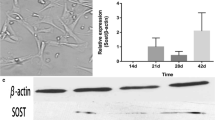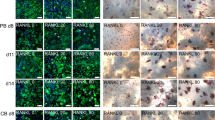Summary
The stimulatory effects of sodium fluoride (NaF) on bone formation have been explained solely, by its activation of osteoblasts. However, whether and how NaF acts on the osteoclast linearge is poorly understood. We previously found that NaF differentiates HL-60 cells to granulocytic cells. To further test this action, we have employed here primary cultures of progenitor cells derived from murine bone marrow. NaF at subtoxic concentations (<0.5 mM) significantly up-regulated activities of several intracellular enzymes (lactate dehydrogenase, β-glucuronidase, acid phosphatase), cellular reduction of nitroblue tetrazolium, and nitric oxide (NO) production; which are all accepted as general differentiation markers. NaF (<0.5 mM) also up-regulated granulocyte-specific markers (chloroacetate esterase, cell surface antigens[Mac-1, Gr-1]) but not any of the monocyte-specific markers (nonspecific esterase, cell surface antigens [F4/80, MOMA-2]). Although other general differentiation markers (phagocytosis, adhesion, appearance, nuclear:cytoplasmic ratio) were not appreciably influenced by NaF, essentially in support of our prevous data from HL-60 cells, the present findings suggest that NaF induces early differentiation of bone marrow hemopoietic progenitor cells along the granulocytic pathway but not the monoicytic pathway that is linked to osteoclast formation. Therefore, in addition to its potent stimulatory effects on osteoblastic bone formation, NaF applied to patients with osteoporosis could be expected to indirectly reduce osteoclastic bone resorption.
Similar content being viewed by others
References
Abrahm, J. L.; Smiley, R. Modification of noirmal human myelopoiesis by 12-O-tetradecanoylphorbol-13-acetate (TPA). Blood 58:1119–1126; 1981.
Briancon, D.; Meunier, P. J. Treatment of osteoporosis with fluoride, calcium and vitamin D. Orthop. Clin. N. Am. 12:629–648; 1981.
Chaplinski, T. J.; Niedel, J. E. Cyclic nucleotide-induced maturation of human promyelocytic leukemia cells. J. Clin. Invest. 70:953–964; 1982.
Chavassieux, P. Bone effects of fluoride in animal models in vivo. A review and a recent study. J. Bone Miner. Res. 5 (Suppl. 1):S95-S99; 1990.
Ding, A. H.; Nathan, C. F.; Stuehr, D. J. Release of reactive nitrogen inter-mediates and reactive oxygen intermediates from mouse peritoneal macrophages. Comparison of activating cytokines and evidence for independent production. J. Immunol. 141:2407–2412; 1988.
Evans, T. J.; Buttery, L. D.; Carpenter, A., et al. Cytokine-treated human neutrophils contain inducible nitric oxide synthase that produce nitration of ingested bacteria. Proc. Natl. Acad. Sci. USA 93:9553–9558; 1996.
Farley, J. R.; Tarbaux, N.; Hall, S.; Baylink, D. Evidence that fluoride-stimulated 3[H]-thymidine incorporation, in embryonic chick calvarial cell cultures is dependent upon the presence of a bone cell mitogen, sensitive to changes in the phosphate concentration, and modulated by systemic skeletal effectors. Metabolism 37:988–995; 1988.
Farley, J. R.; Wergedal, J. E.; Baylink, D. J. Fluoride directly stimulates proliferation and alkaline phosphatase actvity of bone-forming cells. Science 222:330–332; 1983.
Glasser, L.; Fiederlein, R. L. Functional differentiation of normal human neutrophils. Blood 69:937–944; 1987.
Hestdal, K.; Ruscetti, F. W.; Ihle, J. N., et al. Characterization and regulation of RB6-8C5 antigen expression on murine bone marrow cells. J. Immunol. 147:22–28; 1991.
Hirsch, S.; Austyn, J. M.; Gordon, S. Expression of the macrophage-specific antigen F4/80 during differentiation of mouse bone marrow cells in culture. J. Exp. Med. 154:713–725; 1981.
Kawase, T.; Ogata, S.; Orikasa, M.; Burns, D. M. 1,25-dihydroxyvitamin D3 promotes prostaglanding E1-induced differentiation of HL-60 cells. Calcif. Tissue Int. 57:359–366; 1995.
Kawase, T.; Oguro, A.; Orikasa, M.; Burns, D. M. Characteristics of NaF-induced differentiation of HL-60 cells. J. Bone Miner. Res. 11:1676–1687; 1996.
Kawase, T.; Orikasa, M.; Suzuki, A. Aluminofluoride- and epidermal growth factor-stimulated DNA synthesis in MOB 3-4-F2 cells. Pharmacol. Toxicol. 69:330–337; 1991.
Kraal, G.; Rep, M.; Janse, M. Macrophages in T and B cell, compartments and other tissue macrophages recognized by monoclonal antibody MOMA-2. An immunohistochemical study. Scand. J. Immunol. 26:653–661; 1987.
Lau, W.-K. H.; Farley, J. R.; Frieman, T. K.; Baylink, D. A proposed mechanism of the mitogen action of fluoride on bone cells: inhibition of the activity of an osteoblastic acid phosphatase. Metabolism 38:858–868; 1987.
Leibovich, S. J.; Polverini, P. J.; Fong, T. W., et al. Production of angiogenic activity by human monoicytes requires an L-arginine/nitric oxide-synthase-dependent effector mechanism. Proc. Natl. Acad. Sci. USA 91:4190–4194; 1994.
Maly, F. E.; Nakamura, M.; Gauchat, J. F., et al. Superoxide-dependent nitrobule tetrazolium reduction and expression of cytochrome b-245 components by human tonsilar B lymphocytes and B cell lines. J. Immunol. 142:1260–1267; 1989.
Metcalf, D.; Nicola, N. A. Proliferative effects of purified granulocyte colony-stimulating factor (G-CSF) on normal mouse hemopoietic cells. J. Cell. Physiol. 116:198–206; 1983.
Moilanen, E.; Vapaatalo, H. Nitric oxide in inflammation and immune response. Ann. Med. 27:359–367; 1995.
Orikasa, M.; Kawase, T.; Shimizu, F.; Suzuki, A. Establishment of murine macrophage-like mutant and hybrid cell lines: comparative analysis of the differentiation induced by 1α,25-dihydroxyvitamin D3 and recombinant murine interferon-γ. Cell. Immunol. 132:350–365; 1991.
Orikasa, M.; Kawase, T.; Suzuki, A. Induction of macrophagic and granulocytic differentiation of murine bone marrow progenitor cells by 1,25-dihydroxyvitamin D3. Calcif. Tissue Int. 53:193–200; 1993.
Perkins, S. L.; Teitelbaum, S. L. 1,25-Dihydroxyvitamin D3 modulates colonystimulating factor-1 receptor binding by murine bone marrow macrophage precursors. Endocrinology 128:303–311; 1991.
Souza, L. M.; Boone, T. C.; Gabrilove, J., et al. Recombinant human granulocyte colony-stimulating factor: effects on normal and leukemic myeloid cells. Science 232:61–65; 1986.
Stanley, E. R.; Gilbert, L. J.; Tushinski, R. J.; Bartelmez, S. H. CSF-1—a mononuclear phagocyte lineage-specific hematopoietic growth factor. J. Cell. Biochem. 21:151–159; 1983.
Yagaloff, K. A.; Xie, F. Induction of c-fos in mouse bone marrow macrophages: a direct method for assessing bone marrow, cell activation. Biochem. Biophys. Res. Commun. 211:767–773; 1995.
Yoneda, T.; Alsina, M. M.; Garcia, J. L.; Mundy, G. R. Differentiation of HL-60 cells into cells with the osteoclastic phenotype. Endocrinology 129:683–689; 1991.
Zhou, M. J.; Brown, E. J. CR3 (Mac-1, αMβ2, CD11b/CD18) and Fc gamma RIII cooperate in generation of a neutrophil respiratory burst: requirement for Fc gamma RIII and tyrosine phosphorylation. J. Cell Biol. 125:1407–1416; 1994.
Author information
Authors and Affiliations
Corresponding author
Rights and permissions
About this article
Cite this article
Oguro, A., Kawase, T. & Orikasa, M. NaF induces early differentiation of murine bone marrow cells along the granulocytic pathway but not the monocytic, or preosteoclastic pathway in vitro. In Vitro Cell.Dev.Biol.-Animal 39, 243–248 (2003). https://doi.org/10.1290/1543-706X(2003)039<0243:NIEDOM>2.0.CO;2
Received:
Accepted:
Issue Date:
DOI: https://doi.org/10.1290/1543-706X(2003)039<0243:NIEDOM>2.0.CO;2




